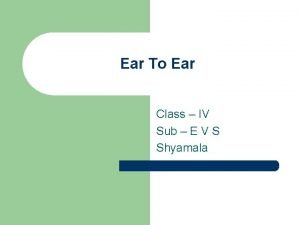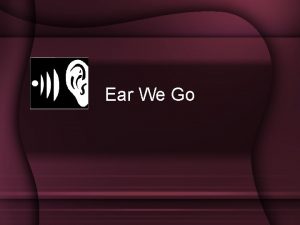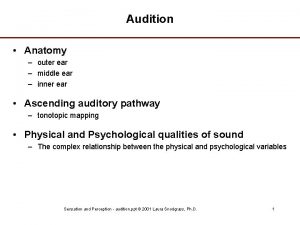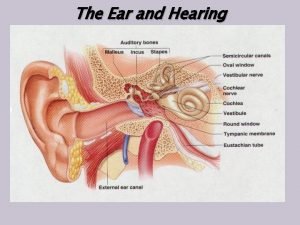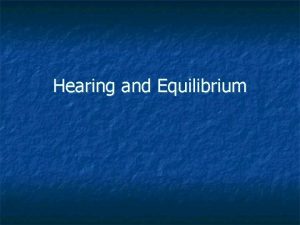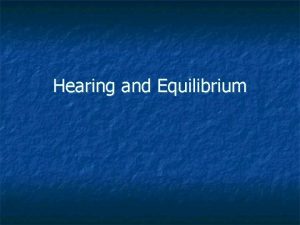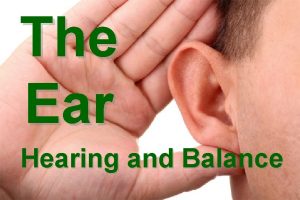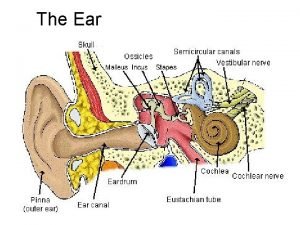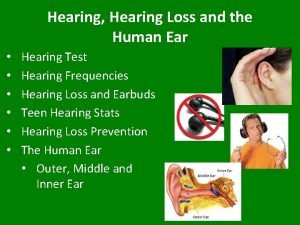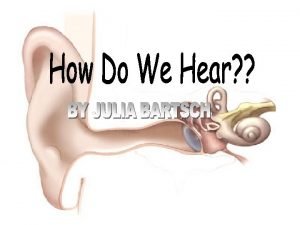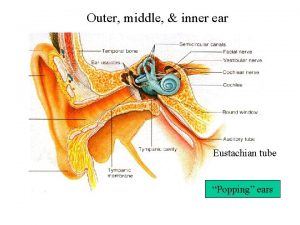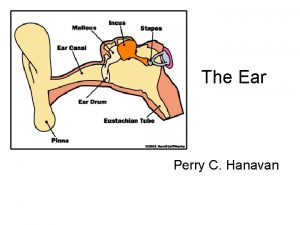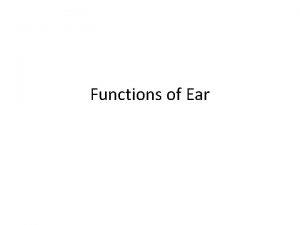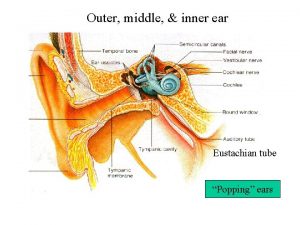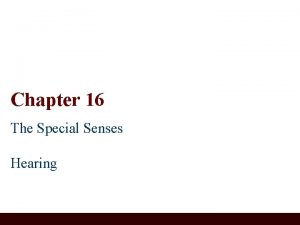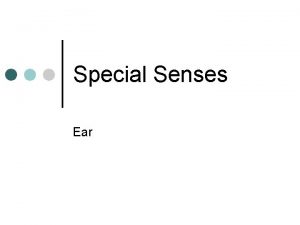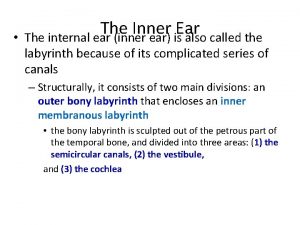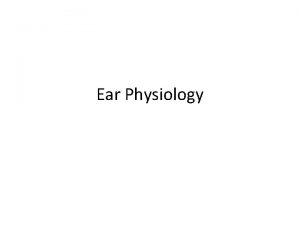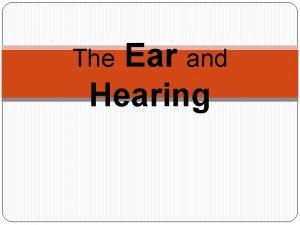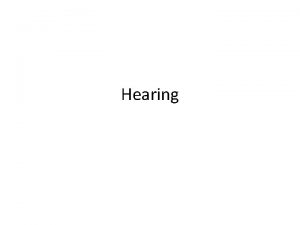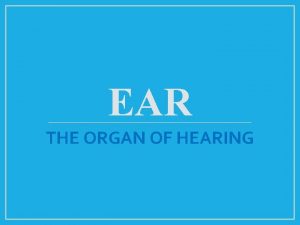Hearing Outer ear The ear has three functional







































- Slides: 39

Hearing

Outer ear The ear has three functional parts. The main part of the external ear, the auricle, captures sound efficiently and sends it into the ear canal. Our capacity to localize sounds in space, especially along the vertical axis, depends critically upon the sound - gathering properties of the external ear.

Middle ear transmits mechanical energy to the ear's receptive organ. The three tiny ossicles, or bones: the malleus, or hammer; the incus, or anvil; and the stapes, or stirrup pass the motions of the tympanic membrane (eardrum) to the oval window – the bony covering of the cochlea.

Reflection and transmission at the eardrum environment (air) Amplitude reflection and transmission coefficients: Z – mechanical impedance (= rv) r - density v – wave propagation speed inner ear (water) Energy reflection and transmission coefficients:

Reflection and transmission at the eardrum rair = 1. 21 kg/m 3 vair = 340 m/s rwater = 103 kg/m 3 vwater = 1480 m/s This values yield energy reflection and transmission coefficients: T = 1 – R = 0. 0011 R = 0. 9989 0. 1% energy transmitted ~99. 9% is reflected If only 1 part in 1000 makes it through, the loss is: 10 log 101/1000 = -30 d. B

The middle ear Purpose of the bones in the middle ear is to serve as amplifying system for the transmission of the eardrum vibrations towards the inner ear. Incus Malleus Stapes ~ 3. 2 mm 2 Tympanic membrane ~ 55 mm 2 Area ratio about 17: 1 gives 17 -fold sound pressure increase. It represents an increase in decibels of: 20 log 1017/1 = 25 d. B

The middle ear Incus 7 mm Malleus 9 mm Malleus/Incus length ratio is 9: 7 so force and hence the pressure is increased by 1. 3: 1 Sound pressure level increase is approximately: 20 log 109/7 = 2 d. B

Eardrum displacement at threshold of hearing Acoustic travelling wave Total wave energy (Epot = Ekin) Wave intensity at the threshold of hearing 0 d. B Wave amplitude at 440 Hz Hydrogen atom diameter The eardrum displacement at threshold of hearing is ~ 1/10 the diameter of a hydrogen atom!

The threshold of hearing At a threshold of 3000 Hz (the frequency to which we are most sensitive – important for speech) the eardrum displacement is about one tenth of the diameter of a single hydrogen atom. In a very quiet setting, blood can actually be heard flowing through the vessels near the ear. If ears were much more sensitive, we would be hearing noise generated by air molecules colliding with the eardrum. A threshold vibration deflects auditory receptors in an inner ear (stereocilia) through an angle of only about 0. 003 degree. Bending the Empire State Building (380 m) through such an angle would deflect its top by less than 2. 5 cm. From this threshold we can hear over a 10 million–fold range of sound pressure levels before sounds become painfully loud. Because it is cumbersome to keep track of all the zeros in such large numbers, a logarithmic decibel scale was introduced.

Sound Intensity and Sound Pressure Levels Human ear responds to sound intensities in the range of 10 -12– 100 W/m 2. Sound intensity level is defined as: where: b – sound intensity level I – sound intensity I 0 – standard reference sound intensity 10– 12 W/m 2 In such scale 10 -fold increase in sound intensity, gives 10 d. B increase in sound volume (intensity level). Sound pressure level (SPL) or sound level is a logarithmic measure of the effective sound pressure of a sound relative to a reference value:

Sound Intensity and Sound Pressure Levels Intensity d. B Pressure Examples 108 W/m 2 200 2*105 Pa Volcano erruption 102 W/m 2 140 2*102 Pa Jet aircraft, 50 m 1 W/m 2 120 2*101 Pa Rock concert 10 -2 W/m 2 100 2 Pa Disco, 1 m from the speaker 10 -4 W/m 2 80 2*10 -1 Pa Highway, 5 m 10 -6 W/m 2 60 2*10 -2 Pa Speech, 1 m 10 -8 W/m 2 40 2*10 -3 Pa Background in quiet library 10 -10 W/m 2 20 2*10 -4 Pa Background in TV studio 10 -12 W/m 2 0 2*10 -5 Pa Hearing threshold Threshold of pain 130 d. B Discomfort threshold, hearing damage possible 120 d. B limit Apple i. Pod volume in Europe 85 d. B

Building a cochlea

Building a cochlea

Building a cochlea

Building a cochlea

Building a cochlea

How cochlea works ? High frequency Low frequency Cochlea in the inner ear is shaped like a snail shell. Net effect is to boost pressure created by sound so that the inner ear fluid can be displaced. Its spiral shape effectively boosts the strength of the vibrations caused by sound, especially for low frequencies.

Cochlea and basilar membrane Cochlea contains basilar membrane, which separates two liquid-filled tubes that run along the cochlea, the scala media and the scala tympani. Basilar membrane is narrow at the base and widens at the tip. Different frequencies are coded by the position along the membrane – high frequencies displace the membrane at the base, low frequencies displace the membrane at the apex.

Helmholtz’s resonance theory of hearing Different frequencies of sound are encoded by their precise position along the basilar membrane. Short strings at the base would resonate in response to high notes, and the long strings (at the apex) to low notes.

The travelling wave theory - Von Bekesy (1928). Nobel 1961 Georg von Békésy (1899 – 1972) A. The sound pressure applied to the oval window produces travelling wave along the basilar membrane. C. The peak displacements for high frequencies are toward the base, and for low frequencies are toward the apex.

Evidence for active amplification mechanism Theory of van Beksy contradicts our daily experience. Envelopes of the travelling waves are wide while we are able to hear pure tones. There must be some additional mechanism for tunning of the auditory system to the sound frequency. The frequency response of individual cochlear nerve fibers depends on a combination of the mechanical properties of the basilar membrane and an active amplification mechanism. Effect of cochlear amplifier. (c) The peak due to cochlear amplifier. (d) Amplitude of the passive movement of basilar membrane with metabolic block applied of the cochlear amplifier.

The Organ of Corti The organ of Corti is the receptor organ of the inner ear, which actively amplifies the travelling wave. It contains the hair cells and a variety of supporting cells. A. Light micrograph of a human organ of Corti. B. Drawing of a cross section of the organ of Corti.

Two types of hair cells Scanning electron micrographs of the organ of Corti after removal of the tectorial membrane. Inner hair cells are arranged in the single row. Outer hair cells are arranged in the three rows and the stereocilia of each cell are arranged in a V configuration.

Inner hair cells are sensory cells; outer hair cells are amplifiers 95 % of the fibers of the auditory nerve arise from the inner hair cells. It suggests that the inner hair cells are actual sensory receptors. Innervation pattern: 20000 nerve fibers connect to the 3500 IHC, while 1000 nerve fibers connect to the 20000 OHC. The IHC are the main sites of auditory transduction.

Outer hair cells Outer hair cell may change its length in response to stimulus. The ‘motor’ is a transmembrane protein that mechanically contracts and elongates the cell. The molecule, discovered in 2000 is called ‘prestin’.

Rock Around the Clock Hair Cell An outer hair cell is being stimulated electrically by a patch pipette which enters from the lower left. The cell’s potential is changed by by plugging Walkman into the input socket of the electrophysiology amplifier. (from: http: //www. ucl. ac. uk/ear/research/ashmorelab)

The cochlear amplifier Shape changes of the outer hair cells due to rapidly oscillating membranne potential contribute to movement of the tectorial and basilar membranes. Inner hair cells are stimulated by the relative movements between these membranes. It is presumed that this mechanism contributes to the active tunning of hair cells responses.

Otoacoustic emission An otoacoustic emission (OAE) is a sound which is generated from within the inner ear. There are two types of otoacoustic emissions: spontaneous otoacoustic emissions, which can occur without external stimulation, and evoked otoacoustic emissions, which require an evoking stimulus. Most probably, otoacoustic emissions are produced by the cochlear outer hair cells as they expand contract. Otoacoustic emissions are the basis of a simple, non-invasive, test for hearing defects in newborn babies. An example of multifrequency spontaneous otoacoustic emissions recorded from a 48 year-old woman with normal hearing. The black spikes represent the response above the noise floor. An example of evoked otoacoustic emissions and their spectra. Evoked otoacoustical emissions are evidence for a cochlear amplifier.

Mechanism of frequency tunning 2 – dependence on the location Many properties of IHC and OHC vary with the position along the cochlea. These differences are likely to be correlated with the differing frequencies that are processed along the cochlea, but the significance of these changes is still not understood.

Efferent fibers In addition to afferent fibers, the auditory nerve also contains efferent fibers, which arises from cells in the brain-stem. Efferent fibers inhibit mainly outer hair cells by hyperpolarizing the hair cells membrane. It reduces the motor output of the outer hair cells and reduces the movement of the tectorial and basilar membranes and the sensory response of the inner hair cells. Its role is assumed to be a protection against overstimulation.

Tunning curves Tuning curves for cochlear hair cells. To construct a curve, the experimenter presents sound at each frequency at increasing amplitudes until the cell produces a criterion response, here 1 m. V. The curve thus reflects the threshold of the cell for stimulation at a range of frequencies. Each cell is most sensitive to a specific frequency. The threshold rises briskly (sensitivity falls abruptly) as the stimulus frequency is raised or lowered.

Auditory pathways: Left Auditory cortex Right Auditory cortex Cochlea - Cochlear nuclei (brainstem) - Superior olivary nuclei (brain-stem) - Inferior colliculus (brain-stem) - Medial geniculate nuclei (thalamus) - Auditory cortex Medial geniculate nucleus Cochlea Inferior colliculus Auditory nerve fiber - Ipsilateral Cochlear nucleus Superior Olivary nucleus

Types of cells in the cochlear nuclei Auditory nerve fibers terminate in the cochlear nuclei (CN) on different types of cells with different response properties. Responses to a tone burst of 50 ms are shown. The ‘Primary-like’ preserve the envelope of the input signal, the ‘Pauser’ and the’Chopper’ provide for differentation between onset and ensuing phases of the tone, the ‘On’ cells signal the onset or timing of a sound. Each cell type represents an abstraction of one particular feature of the input. Different functional properties are processed and transmitted in parallel pathways. In humans, the receptor potentials of certain hair cells and the action potentials of their associated auditory nerve fiber can follow stimuli of up to about 3 k. Hz in a one-to-one fashion.

Sound localization in medial superior olive nuclei Diagram illustrating how the MSO computes the location of a sound by interaural time differences. A given MSO neuron responds most strongly when the two inputs arrive simultaneously, as occurs when the contralateral and ipsilateral inputs precisely compensate (via their different lengths) for differences in the time of arrival of a sound at the two ears. The systematic (and inverse) variation in the delay lengths of the two inputs creates a map of sound location: In this model, E would be most sensitive to sounds located to the left, and A to sounds from the right; C would respond best to sounds coming from directly in front of the listener. Psychophysical experiments show that humans can actually detect interaural time differences as small as 10 microseconds; This sensitivity translates into an accuracy for sound localization of about 1°. Interaural time differences are used to localize the source for frequencies below 3 k. Hz.

Sound localization in lateral superior olive nuclei Lateral superior olive neurons encode sound location through interaural intensity differences. LSO neurons receive direct excitation from the ipsilateral cochlear nucleus; input from the contralateral cochlear nucleus is relayed via inhibitory interneurons in the MNTB (medial nucleus of the trapezoid body). This excitatory/inhibitory interaction results in a net excitation of the LSO on the same side of the body as the sound source. In contrast, sounds arising from in front of the listener, will silence the LSO output. Interaural intensity differences are used to localize the source for frequencies above 2 k. Hz.

Tonotopic organisation The basilar membrane in the cochlea is tonotopically organized. The tonotopic organization is retained at all levels of the central auditory system.

The auditory cortex Diagram showing the brain in left lateral view, including the depths of the lateral sulcus, where part of the auditory cortex occupying the superior temporal gyrus normally lies hidden. The primary auditory cortex (A 1) is shown in blue; the surrounding belt areas of the auditory cortex are in red. The primary auditory cortex has a tonotopic organization, as shown in the blowup diagram of a segment of A 1. The Wernicke's area shown in green is a region important in comprehending speech. It is just posterior to the primary auditory cortex.

Tonotopic mapping in auditory cortex Tonotopic mapping in human primary auditory cortex, demonstrated by applying 500 -msec tone bursts at five different sound frequencies to one ear while mapping the magnetic field changes produced by neuronal current flow in primary auditory cortex. Location of the primary auditory cortex in the transverse temporal gyri is visible.

frequency Tritone paradox sequence Shepard tones. Each square in the figure indicates a tone, with any set of squares in vertical alignment together making one Shepard tone. The color of each square indicates the loudness of the note, with purple being the quietest and green the loudest. Overlapping notes in one Shepard tone are exactly one octave apart. A pair of Shepard tones separated by an interval of a tritone (half an octave) produces the tritone paradox. They may be heard as either descending or ascending and constitute a bistable figure in auditory domain.
 Animals whose ears we cannot see
Animals whose ears we cannot see Whose ears cannot be seen
Whose ears cannot be seen Cantilever type space maintainer
Cantilever type space maintainer Functional and non functional plasma enzymes
Functional and non functional plasma enzymes Enzymes of blood plasma
Enzymes of blood plasma Functional and non functional
Functional and non functional What elements had complete outer shells
What elements had complete outer shells Hình ảnh bộ gõ cơ thể búng tay
Hình ảnh bộ gõ cơ thể búng tay Bổ thể
Bổ thể Tỉ lệ cơ thể trẻ em
Tỉ lệ cơ thể trẻ em Voi kéo gỗ như thế nào
Voi kéo gỗ như thế nào Thang điểm glasgow
Thang điểm glasgow Alleluia hat len nguoi oi
Alleluia hat len nguoi oi Các môn thể thao bắt đầu bằng tiếng chạy
Các môn thể thao bắt đầu bằng tiếng chạy Thế nào là hệ số cao nhất
Thế nào là hệ số cao nhất Các châu lục và đại dương trên thế giới
Các châu lục và đại dương trên thế giới Công của trọng lực
Công của trọng lực Trời xanh đây là của chúng ta thể thơ
Trời xanh đây là của chúng ta thể thơ Mật thư tọa độ 5x5
Mật thư tọa độ 5x5 Phép trừ bù
Phép trừ bù độ dài liên kết
độ dài liên kết Các châu lục và đại dương trên thế giới
Các châu lục và đại dương trên thế giới Thơ thất ngôn tứ tuyệt đường luật
Thơ thất ngôn tứ tuyệt đường luật Quá trình desamine hóa có thể tạo ra
Quá trình desamine hóa có thể tạo ra Một số thể thơ truyền thống
Một số thể thơ truyền thống Cái miệng xinh xinh thế chỉ nói điều hay thôi
Cái miệng xinh xinh thế chỉ nói điều hay thôi Vẽ hình chiếu vuông góc của vật thể sau
Vẽ hình chiếu vuông góc của vật thể sau Biện pháp chống mỏi cơ
Biện pháp chống mỏi cơ đặc điểm cơ thể của người tối cổ
đặc điểm cơ thể của người tối cổ Ví dụ về giọng cùng tên
Ví dụ về giọng cùng tên Vẽ hình chiếu đứng bằng cạnh của vật thể
Vẽ hình chiếu đứng bằng cạnh của vật thể Vẽ hình chiếu vuông góc của vật thể sau
Vẽ hình chiếu vuông góc của vật thể sau Thẻ vin
Thẻ vin đại từ thay thế
đại từ thay thế điện thế nghỉ
điện thế nghỉ Tư thế ngồi viết
Tư thế ngồi viết Diễn thế sinh thái là
Diễn thế sinh thái là Các loại đột biến cấu trúc nhiễm sắc thể
Các loại đột biến cấu trúc nhiễm sắc thể Số nguyên tố là gì
Số nguyên tố là gì

